Processing and Evaluation of a Carbon Fiber Reinforced Composite Bar Using a Closed Impregnation Pultrusion System with Improved Production Speed
Abstract
:1. Introduction
2. Materials and Methods
2.1. CFRP Bar Pultrusion System Using Closed Impregnation Device
2.2. Improvement of Fiber Feeder System through Spreading
2.3. Characterization Method
2.3.1. Void Fraction Analysis
2.3.2. Measurement of Surface Roughness
2.3.3. Cantilever Test and Three-Point Bending Test
3. Results
3.1. Measurement of Resin Viscosity and Impregnation Behavior
3.2. Evaluation of CFRP Bar by Different Process Parameters
3.2.1. Void Fraction
3.2.2. Surface Roughness
3.2.3. Bending Properties
4. Conclusions
Author Contributions
Funding
Data Availability Statement
Conflicts of Interest
References
- Krenkel, W. Carbon Fiber Reinforced CMC for High-Performance Structures. Int. J. Appl. Ceram. Technol. 2004, 1, 188–200. [Google Scholar] [CrossRef]
- Gohardani, O.; Elola, M.C.; Elizetxea, C. Potential and prospective implementation of carbon nanotubes on next generation aircraft and space vehicles: A review of current and expected applications in aerospace sciences. Prog. Aerosp. Sci. 2014, 70, 42–68. [Google Scholar] [CrossRef]
- Hsissou, R.; Seghiri, R.; Benzekri, Z.; Hilali, M.; Rafik, M.; Elharfi, A. Polymer composite materials: A comprehensive review. Compos. Struct. 2021, 262, 113640. [Google Scholar] [CrossRef]
- Mallick, P.K. Advanced materials for automotive applications: An overview. Adv. Mater. Automot. Eng. 2012, 5–27. [Google Scholar] [CrossRef]
- Stewart, R. Carbon fibre composites poised for dramatic growth. Reinf. Plast. 2009, 53, 16–21. [Google Scholar] [CrossRef]
- Forintos, N.; Czigany, T. Multifunctional application of carbon fiber reinforced polymer composites: Electrical properties of the reinforcing carbon fibers—A short review. Compos. Part B Eng. 2019, 162, 331–343. [Google Scholar] [CrossRef]
- Witik, R.A.; Teuscher, R.; Michaud, V.; Ludwig, C.; Månson, J.-A.E. Carbon fibre reinforced composite waste: An environmental assessment of recycling, energy recovery and landfilling. Compos. Part A Appl. Sci. Manuf. 2013, 49, 89–99. [Google Scholar] [CrossRef]
- Friedrich, K.; Almajid, A.A. Manufacturing Aspects of Advanced Polymer Composites for Automotive Applications. Appl. Compos. Mater. 2013, 20, 107–128. [Google Scholar] [CrossRef]
- Jang, B.Z. Advanced Polymer Composites: Principles and Applications; ASM International: Materials Park, OH, USA, 1994. [Google Scholar]
- Zhang, J.; Chevali, V.S.; Wang, H.; Wang, C.-H. Current status of carbon fibre and carbon fibre composites recycling. Compos. Part B Eng. 2020, 193, 108053. [Google Scholar] [CrossRef]
- Qureshi, J. A Review of Fibre Reinforced Polymer Structures. Fibers 2022, 10, 27. [Google Scholar] [CrossRef]
- Liu, T.Q.; Xing, L.; Peng, F. A comprehensive review on mechanical properties of pultruded FRP composites subjected to long-term environmental effects. Compos. Part B Eng. 2020, 191, 107958. [Google Scholar] [CrossRef]
- Khan, L.A.; Mehmood, A.H. Cost-effective composites manufacturing processes for automotive applications. Lightweight Compos. Struct. Transp. 2016, 93–119. [Google Scholar] [CrossRef]
- Joshi, S.C. The pultrusion process for polymer matrix composites. Manuf. Tech. Polym. Matrix Compos. (PMCs) 2012, 381–413. [Google Scholar] [CrossRef]
- Arrabiyeh, P.A.; May, D.; Eckrich, M.; Dlugaj, A.M. An overview on current manufacturing technologies: Processing continuous rovings impregnated with thermoset resin. Polym. Compos. 2021, 42, 5630–5655. [Google Scholar] [CrossRef]
- Voorakaranam, S.; Joseph, B.; Kardos, J.L. Modeling and Control of an Injection Pultrusion Process. J. Compos. Mater. 1999, 33, 1173–1204. [Google Scholar] [CrossRef]
- Irfan, M.S.; Shotton-Gale, N.; Paget, M.A.; Machavaram, V.R.; Leek, C.; Wootton, S.; Hudson, M.; Helsmans, S.; Bogonez, F.N.; Pandita, S.D.; et al. A modified pultrusion process. J. Compos. Mater. 2016, 51, 1925–1941. [Google Scholar] [CrossRef] [Green Version]
- Strauß, S.; Senz, A.; Ellinger, J. Comparison of the Processing of Epoxy Resins in Pultrusion with Open Bath Impregnation and Closed-Injection Pultrusion. J. Compos. Sci. 2019, 3, 87. [Google Scholar] [CrossRef] [Green Version]
- Irfan, M.S.; Machavaram, V.R.; Mahendran, R.S.; Shotton-Gale, N.; Wait, C.F.; Paget, M.A.; Hudson, M.; Fernando, G.F. Lateral spreading of a fiber bundle via mechanical means. J. Compos. Mater. 2012, 46, 311–330. [Google Scholar] [CrossRef]
- Wilson, S.D.R. Lateral spreading of fibre tows. J. Eng. Math. 1997, 32, 19–26. [Google Scholar] [CrossRef]
- Roh, J.U.; Woo, I.L. Continuous fiber tow spreading technologies and its applications. Compos. Res. 2013, 26, 155–159. [Google Scholar] [CrossRef]
- Park, C.H.; Krawczak, P. Unsaturated and Saturated Permeabilities of Fiber Reinforcement: Critics and Suggestions. Front. Mater. 2015, 2, 38. [Google Scholar] [CrossRef] [Green Version]
- Becker, D.; Grössing, H.; Konstantopoulos, S.; Fauster, E.; Mitschang, P.; Schledjewski, R. An evaluation of the reproducibility of ultrasonic sensor-based out-of-plane permeability measurements: A benchmarking study. Adv. Manuf. Polym. Compos. Sci. 2016, 2, 34–45. [Google Scholar] [CrossRef] [Green Version]




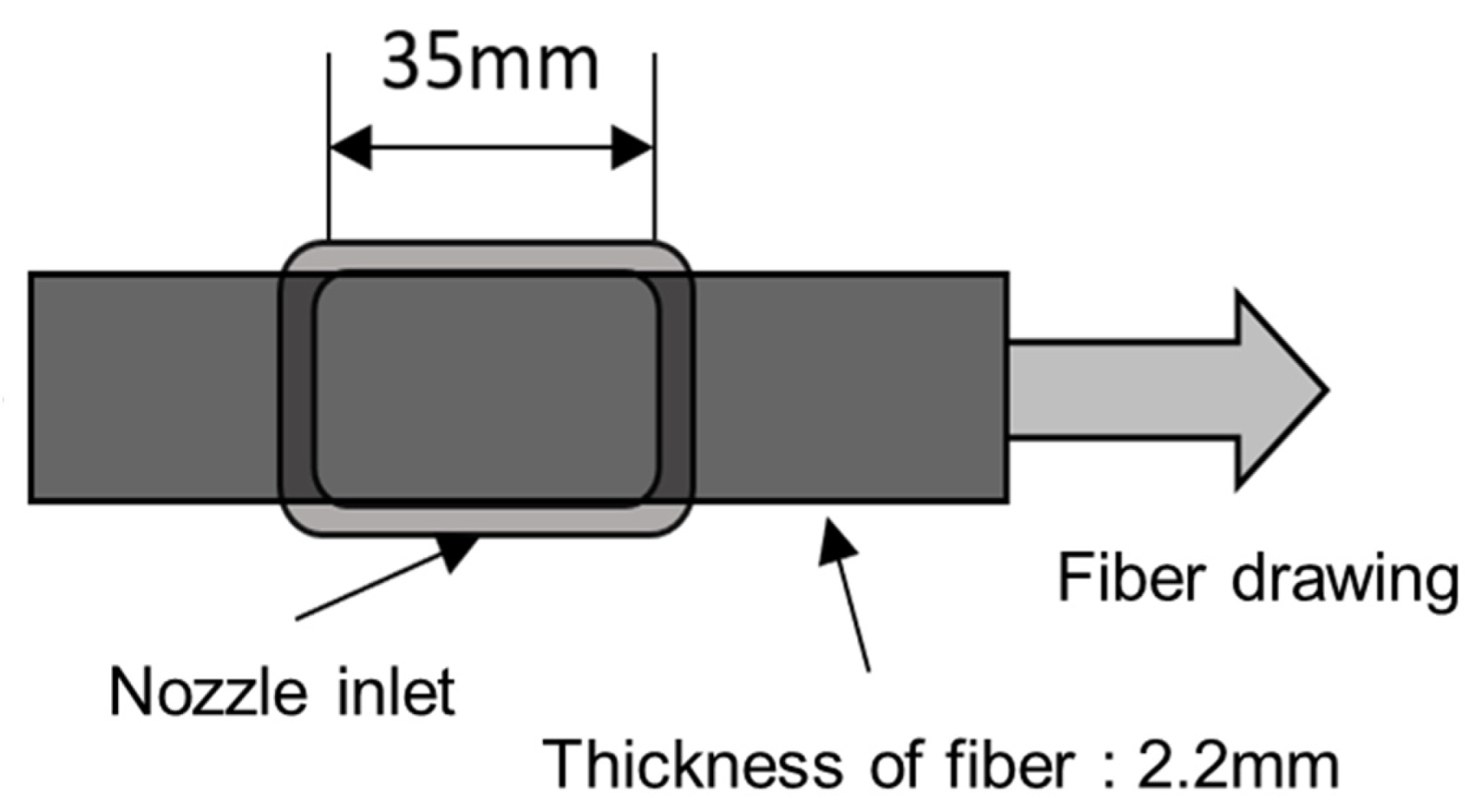

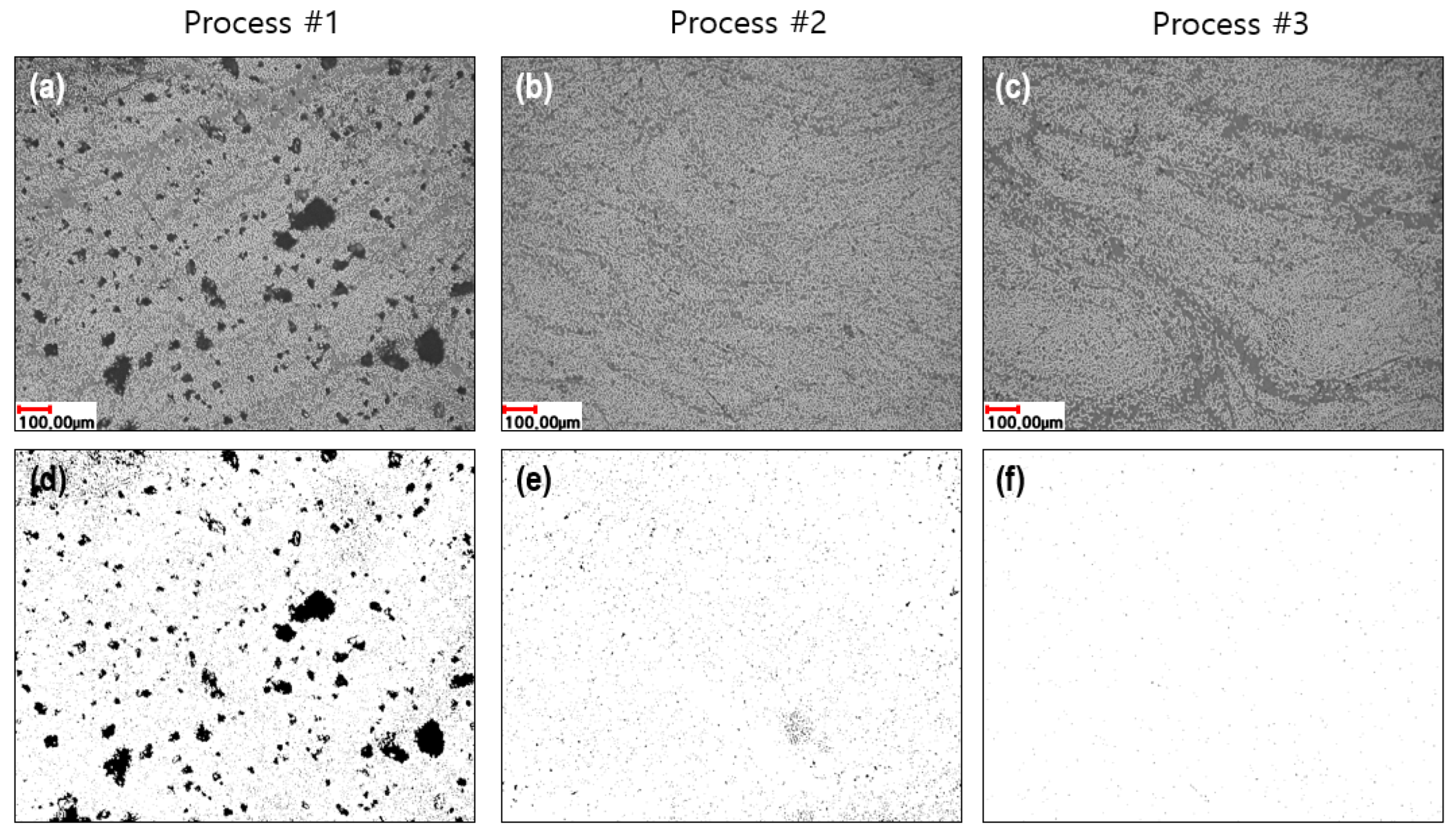
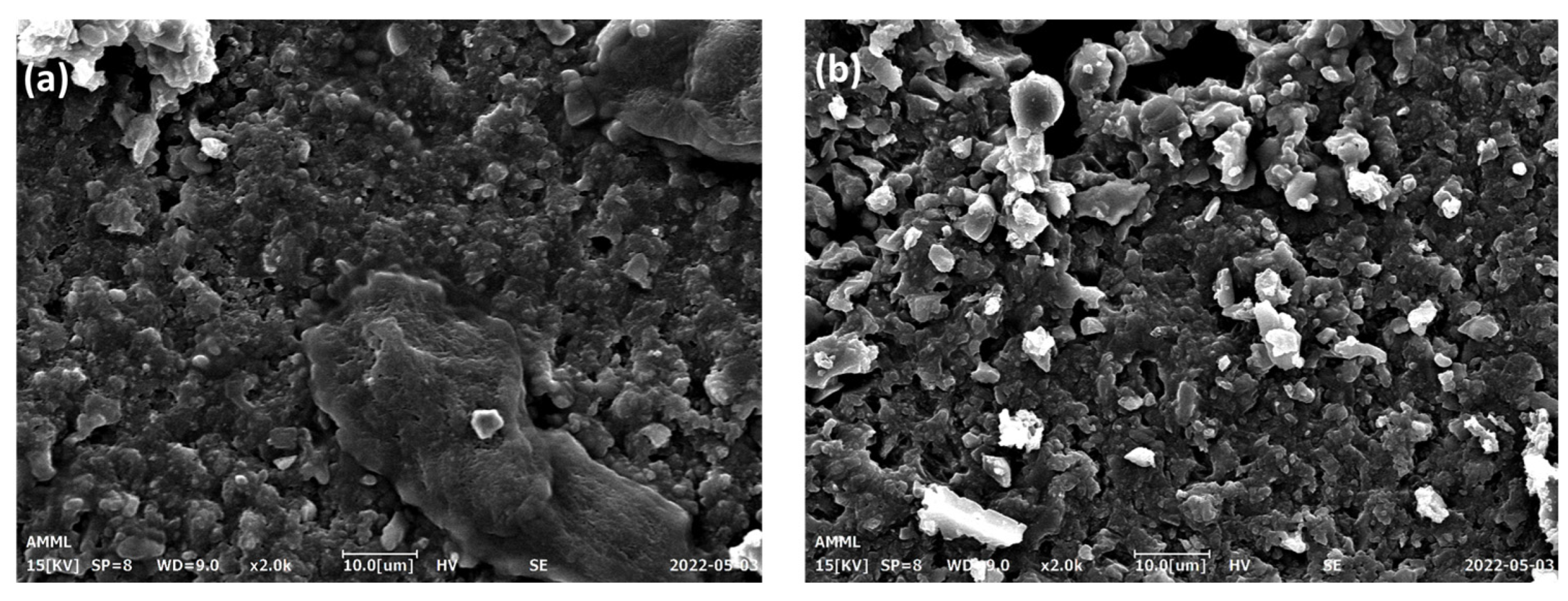
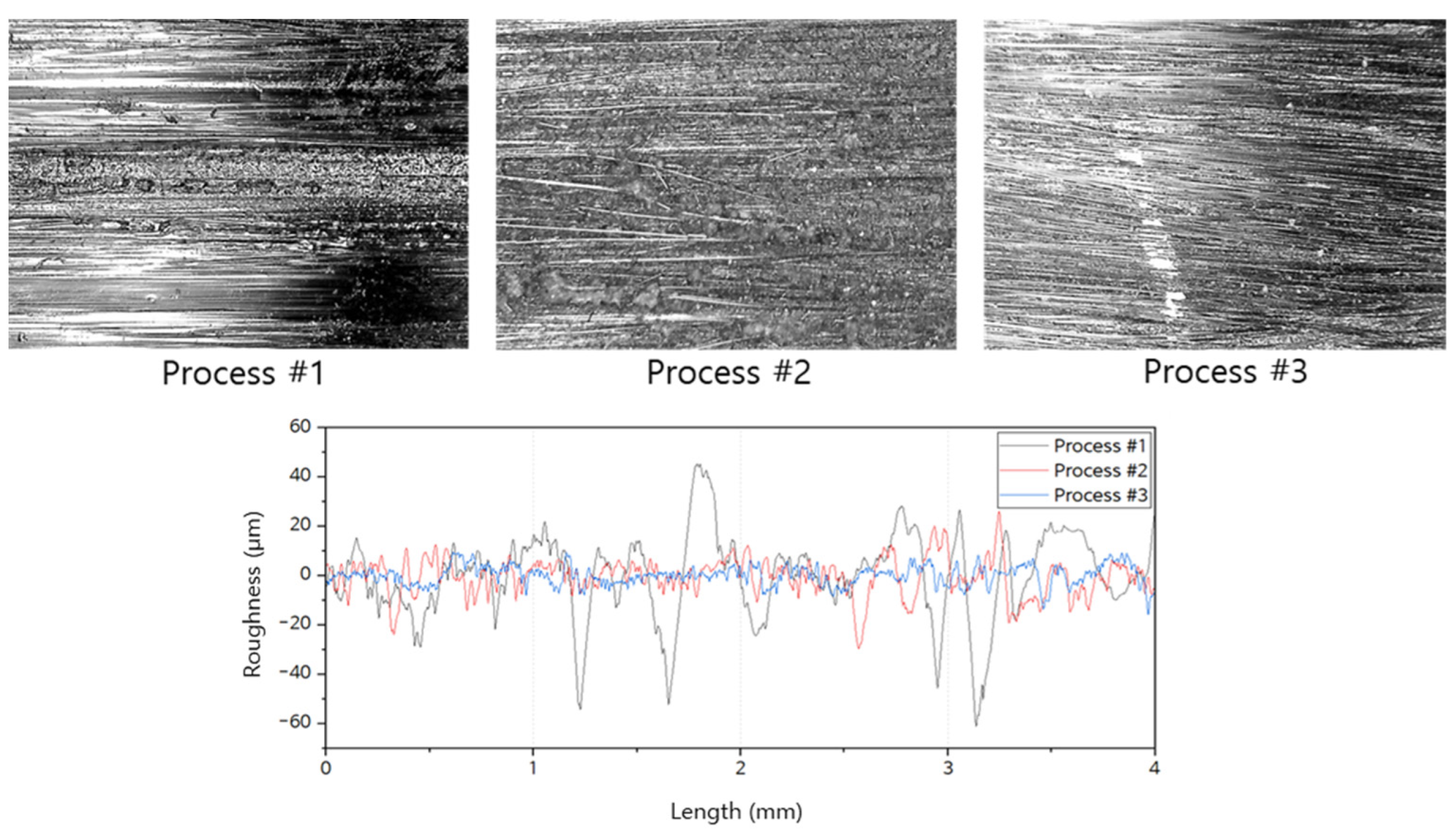
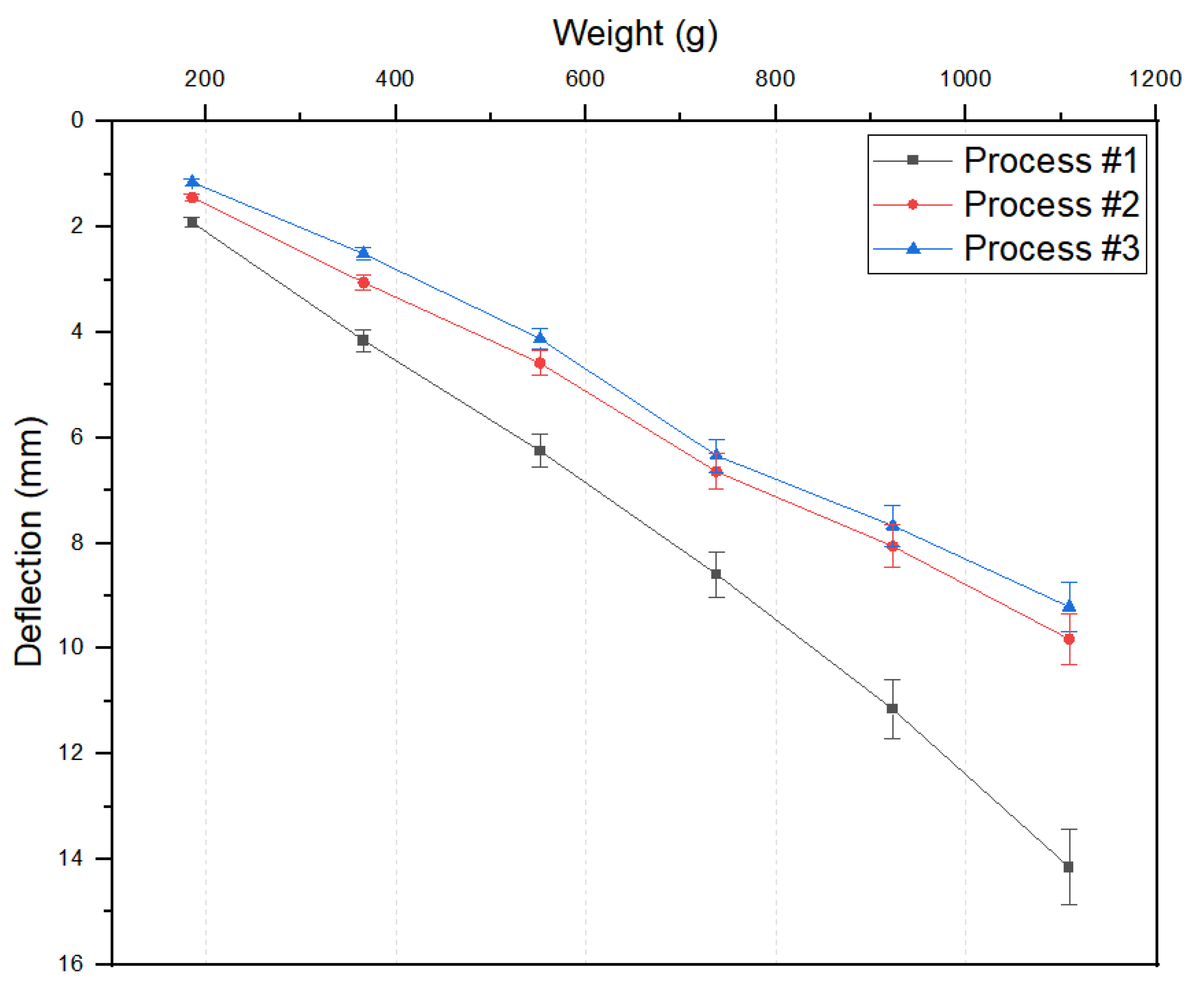
| Temp. | Resin (mPa·s) | Hardener (mPa·s) | Mixed (mPa·s) |
|---|---|---|---|
| 20 | 2949.0 | 319.4 | 1186.0 |
| 30 | 830.8 | 198.2 | 465.9 |
| 40 | 353.9 | 100.8 | 220.4 |
| 50 | 159.5 | 76.3 | 115.4 |
| 60 | 91.5 | 55.8 | 97.1 |
| 70 | 65.7 | 42.1 | 84.5 |
| 80 | 47.8 | 31.3 | - |
| Pultrusion Speed (mm/min) | Impregnation Thickness (mm) | Impregnation Time (s) | Viscosity (mPa·s) |
|---|---|---|---|
| 400 | 2.2 | 5.25 | 552.0 |
| 500 | 2.2 | 4.2 | 441.6 |
| 600 | 2.2 | 3.5 | 368.0 |
| Process | Impregnation Temperature (°C) | Pultrusion Speed (mm/min) | Fiber Spreading Yes/No | Curing Temperature (°C) |
|---|---|---|---|---|
| Process #1 | 20 | 400 | No | 140 or higher |
| Process #2 | 30 | 600 | Yes | 140 or higher |
| Process #3 | 40 | 600 | Yes | 140 or higher |
| No. | Process #1 (μm) | Process #2 (μm) | Process #3 (μm) |
|---|---|---|---|
| 1 | 8.27 | 5.69 | 3.13 |
| 2 | 7.94 | 5.90 | 2.86 |
| 3 | 12.78 | 5.75 | 3.05 |
| 4 | 10.49 | 4.56 | 2.35 |
| 5 | 9.11 | 4.49 | 3.06 |
| Max | 12.78 (1.97) | 5.90 0.69) | 3.13 (0.32) |
| No. | Weight (g) | Process #1 Deflection (mm) | Process #2 Deflection (mm) | Process #3 Deflection (mm) |
|---|---|---|---|---|
| 1 | 190 | 1.91 | 1.44 | 1.15 |
| 2 | 370 | 4.15 | 3.05 | 2.51 |
| 3 | 560 | 6.25 | 4.58 | 4.12 |
| 4 | 740 | 8.59 | 6.64 | 6.34 |
| 5 | 920 | 11.15 | 8.06 | 7.67 |
| 6 | 1100 | 14.15 | 9.82 | 9.21 |
| No. | Process #1 (MPa) | Process #2 (MPa) | Process #3 (MPa) |
|---|---|---|---|
| 1 | 15.5 | 20.1 | 32.2 |
| 2 | 23.8 | 24.4 | 36.1 |
| 3 | 18.7 | 25.2 | 24.2 |
| 4 | 19.9 | 32.5 | 28.2 |
| 5 | 16.8 | 23.2 | 40.0 |
| Average | 19.0 (3.2) | 25.1 (4.6) | 32.2 (6.2) |
| No. | Void (%) | Surface Roughness (μm) | Deflection (mm) | Bending Strength (MPa) |
|---|---|---|---|---|
| Process #1 | 9.595 | 12.78 | 14.15 | 19.0 |
| Process #2 | 1.408 | 5.9 | 9.82 | 25.1 |
| Process #3 | 0.122 | 3.13 | 9.21 | 32.2 |
| Process #2 Improvement | 85.3% | 53.8% | 30.6% | 32% |
| Process #3 Improvement | 98.7% | 75.5% | 34.9% | 70% |
Publisher’s Note: MDPI stays neutral with regard to jurisdictional claims in published maps and institutional affiliations. |
© 2022 by the authors. Licensee MDPI, Basel, Switzerland. This article is an open access article distributed under the terms and conditions of the Creative Commons Attribution (CC BY) license (https://creativecommons.org/licenses/by/4.0/).
Share and Cite
Kang, B.; Lee, C.; Kim, S.-M.; Yoo, H.-M. Processing and Evaluation of a Carbon Fiber Reinforced Composite Bar Using a Closed Impregnation Pultrusion System with Improved Production Speed. Appl. Sci. 2022, 12, 4906. https://doi.org/10.3390/app12104906
Kang B, Lee C, Kim S-M, Yoo H-M. Processing and Evaluation of a Carbon Fiber Reinforced Composite Bar Using a Closed Impregnation Pultrusion System with Improved Production Speed. Applied Sciences. 2022; 12(10):4906. https://doi.org/10.3390/app12104906
Chicago/Turabian StyleKang, Byungsoo, Changki Lee, Seung-Mo Kim, and Hyeong-Min Yoo. 2022. "Processing and Evaluation of a Carbon Fiber Reinforced Composite Bar Using a Closed Impregnation Pultrusion System with Improved Production Speed" Applied Sciences 12, no. 10: 4906. https://doi.org/10.3390/app12104906






